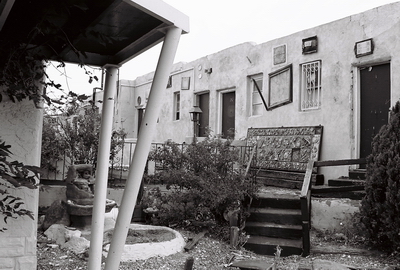
Let’s go back to the recently-deceased Aztec Motel for part two in a two-part series on the place. In my LAST POST, I laid out the physical history of what, until this past summer, was one of Albuquerque’s most historic motels along old Route 66, its early 1930’s construction actually pre-dating the designation of that famous cross-country highway by a few years. If all the Aztec Motel had going for it was its architectural history, it would still be more than worthy of attention. But the Aztec was easily the most unique motel in Albuquerque and this post will shine what might be one last light on its more unusual aspects.
The source of much of the Aztec’s latter-day fame was the hard-to-miss fact that it was decorated from top to bottom, back to front with found objects. Sometimes these objects were actual art, like framed pictures and ornamental sculptures, and sometimes the art was created out of tires or bottles or whatever came to hand. By the time I first saw the Aztec in late 2009, some of this art was already gone. In the photo below, taken just before demolition, most of the objects have been removed. The Aztec’s last owner said that a few people asked for individual pieces when the end was nigh, but most of the art was very damaged and just thrown away. I wish I’d taken my one opportunity to crawl in a back window and rescue the large painting of a Spanish woman that hung just above where the front desk used to be. Alas.

Anyway, the decorating of the Aztec can be traced back to one woman, Phyllis Evans, a retired professor of social work at Michigan State University. In “History Takes a Lick,” an article by Leslie Linthicum on the demise of the Aztec Motel which was published in the Albuquerque Journal, Evans is quoted in a 1999 interview as saying that she never planned to live in a motel and only came to the Aztec by “some miracle.” She moved into the motel in 1994 and almost immediately started decorating.
From the ABQ Journal piece: “Several days into Evans’ stay, she found an empty whiskey bottle outside her door in the morning and stuck a flower in it. The whiskey bottles kept showing up. And Evans kept filling them with plastic flowers and setting them around the motel. Street people started dropping off bottles, flowers and other objects they had found on the street — broken plates, statues, a hobby horse, a Buddha — and Evans continued to build on her outdoor artwork.”
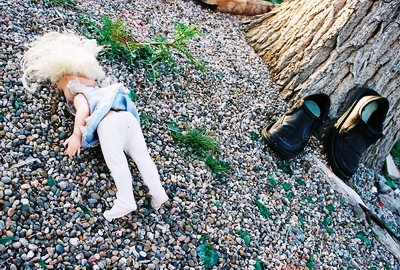
Here's further description from a Daily Lobo article written by Marcella Ortega in late 2006: “Evans covered the building with multicolored Mexican tiles, perforated metal crosses and plates, Mexican and American Indian paintings and wood-carved musical instruments. There are tables with candles outside each unit, too.”
Evans moved out of the motel just after its most recent owner, the Nob Hill Development Corp., bought the property in 2006. She went to Hawaii but stayed in touch, sending desserts to the partners in the development corporation while, outside the motel, her influence lived on.
Jae Whitehorse, who had been living at the motel for three months when interviewed for the Daily Lobo piece, mentioned that he was particularly fond of a mannequin in a 1920's flapper costume and brown fur shawl.
"She's gorgeous, only she's missing one hand," he said, and, describing the motel, added, "It's not all prim and proper. It sort of has a wildness look to it. I don't like things all prim, proper and preppy. The place is funky and quirky and accepting of the weird, which I am, and I fit right in. I love it here." Whitehorse said that the motel's residents and staff were like a family.
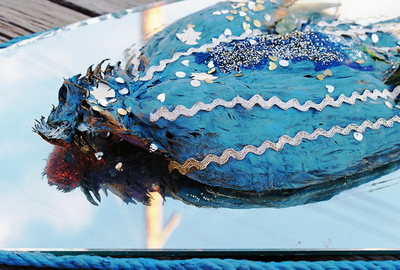
On my first visit to the Aztec Motel, my attention was immediately drawn from the decorations on the motel itself to the decorating that had recently been undertaken in the back parking lot. This was not the work of Phyllis Evans, but of someone with a somewhat darker, yet no-less individual, vision. First, two ornately decorated pigeons, one blue and one red, were laid out on mirrors atop a wooden cable spool. Next, a few feet to the west, numerous stuffed animals were tied to a tree at the base of which a doll laid face-down. Against the tree trunk was propped a pair of dress shoes. And high up in the branches, above the other toys, swung a lone stuffed gorilla. The overall effect was incredible. This was like no place I had ever visited. I looked at the old motel rooms and noticed lights on outside one or two. Had someone squatting in the motel created this?

I returned several times over the following weeks and months. The pigeons began to decay and eventually disappeared. They were replaced by hand-written notes, one of which said, “Practice random acts of public humiliation.”
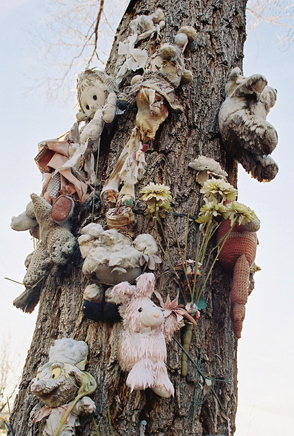 The stuffed toys began to lose their stuffing, with the gorilla bleeding badly out of a large hole in its side. Once I found a collection of CD’s stacked in a corner of the concrete fence. They were not in cases, but were carefully tucked away beside some beer bottles. The music wasn’t what I would have expected, but was better, more obscure, and included the likes of Captain Beefheart, which seemed perfect. In the end, all that remained were some last weather-beaten stuffed animals tied to the tree. The demolition team took down not just those ragged creatures, but the entire tree as well. I wonder what their thoughts were as they considered the last hours of the Aztec Motel.
The stuffed toys began to lose their stuffing, with the gorilla bleeding badly out of a large hole in its side. Once I found a collection of CD’s stacked in a corner of the concrete fence. They were not in cases, but were carefully tucked away beside some beer bottles. The music wasn’t what I would have expected, but was better, more obscure, and included the likes of Captain Beefheart, which seemed perfect. In the end, all that remained were some last weather-beaten stuffed animals tied to the tree. The demolition team took down not just those ragged creatures, but the entire tree as well. I wonder what their thoughts were as they considered the last hours of the Aztec Motel.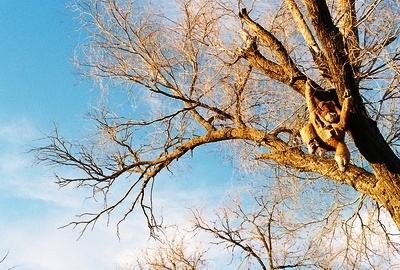
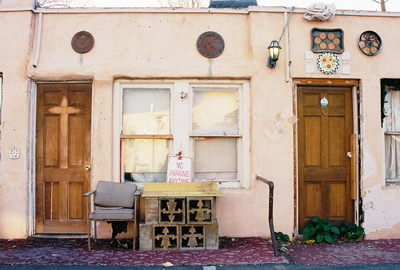
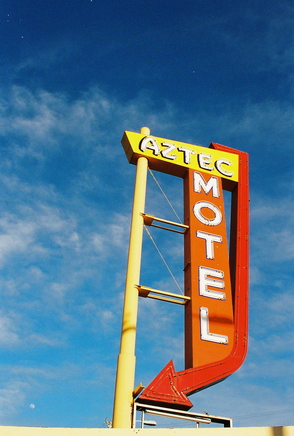 The Aztec Motel was actually the first motel built on East Central Ave. There seems to be some disagreement as to whether it was built in 1931, 1932, or 1933, but it certainly pre-dated Route 66, which was not designated until 1937. Built in a style known as “Southwest Vernacular” and originally called the Aztec Auto Court, the motel had 13 units and three carports. The carports were walled-in sometime in the 1950’s and turned into four additional rooms. This is also when the original neon sign was replaced with the one that can still be seen beside the now-empty lot.
The Aztec Motel was actually the first motel built on East Central Ave. There seems to be some disagreement as to whether it was built in 1931, 1932, or 1933, but it certainly pre-dated Route 66, which was not designated until 1937. Built in a style known as “Southwest Vernacular” and originally called the Aztec Auto Court, the motel had 13 units and three carports. The carports were walled-in sometime in the 1950’s and turned into four additional rooms. This is also when the original neon sign was replaced with the one that can still be seen beside the now-empty lot.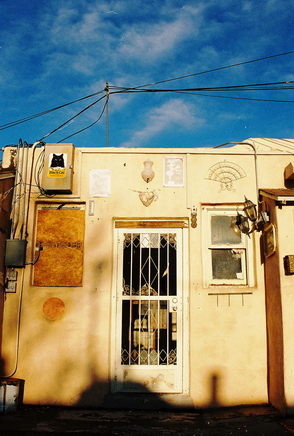 In any case, in 1991, Mohamed Natha bought the motel and worked to bring it back from the brink. In an effort to cut down on visits by hookers and their clients, as well as drug addicts and petty criminals, Natha began to rent only to long-term residents. A short time later the Aztec began to be extravagantly decorated with found items (of which I’ll say more next time) and underwent a kind of renaissance. The long-term residents were chiefly artists, free spirits, and assorted characters-about-town whose personalities became reflected in the motel itself as a genuine community developed.
In any case, in 1991, Mohamed Natha bought the motel and worked to bring it back from the brink. In an effort to cut down on visits by hookers and their clients, as well as drug addicts and petty criminals, Natha began to rent only to long-term residents. A short time later the Aztec began to be extravagantly decorated with found items (of which I’ll say more next time) and underwent a kind of renaissance. The long-term residents were chiefly artists, free spirits, and assorted characters-about-town whose personalities became reflected in the motel itself as a genuine community developed.